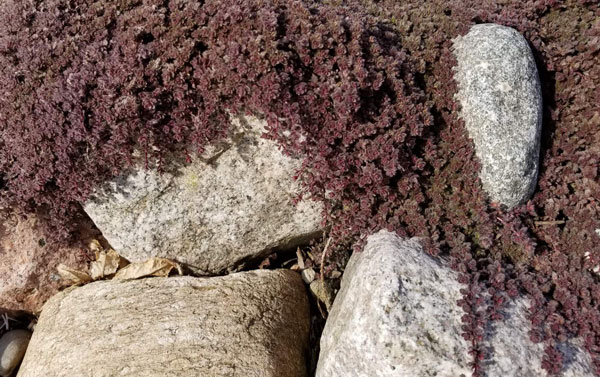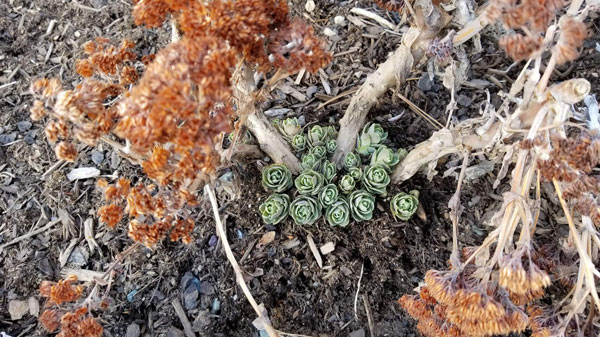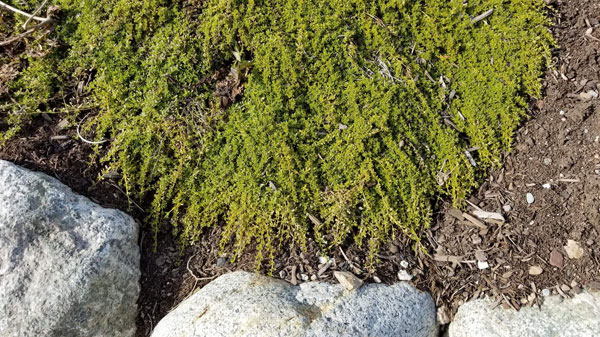 I went for a walk around our gardens this evening looking for the many signs that spring has finally begun turning the lifeless winter landscape back into the lush and colourful one we have missed for months. Plant growth is painfully slow now, gradually building in a bell curve to a peak in June and July, when some plants grow an inch a day, and flowers fade and appear almost constantly. A garden stroll is always a journey of discovery, finding new buds, leaves, shoots, and flowers that weren’t there last time, the thrill of new blooms mixing with the regret that others are already finished for the season. It’s like watching an action movie in June… so much detail it’s hard to follow at times, but thrilling none-the-less. Now the experience is more subtle- many are still outwardly dormant, others just peeking through the mulch, very few daring to venture a flower or two. Yet the experience can be equally rewarding for the gardener, looking very closely at the buds on the shrubs, the bases of perennials, and the foliage of all evergreens for those modest changes that are increasing every day now.
I went for a walk around our gardens this evening looking for the many signs that spring has finally begun turning the lifeless winter landscape back into the lush and colourful one we have missed for months. Plant growth is painfully slow now, gradually building in a bell curve to a peak in June and July, when some plants grow an inch a day, and flowers fade and appear almost constantly. A garden stroll is always a journey of discovery, finding new buds, leaves, shoots, and flowers that weren’t there last time, the thrill of new blooms mixing with the regret that others are already finished for the season. It’s like watching an action movie in June… so much detail it’s hard to follow at times, but thrilling none-the-less. Now the experience is more subtle- many are still outwardly dormant, others just peeking through the mulch, very few daring to venture a flower or two. Yet the experience can be equally rewarding for the gardener, looking very closely at the buds on the shrubs, the bases of perennials, and the foliage of all evergreens for those modest changes that are increasing every day now.
T his is a time too, before planting and weeding seem to take all our attention and time, to look critically at the various beds, appreciate the successes of last year and plan to build on them, while fixing the flaws, by dividing, regrouping, transplanting, adding focal plants, statuary, or whatever comes to mind. Mind you, though, such analysis can replace relaxation, which was the prime purpose of my stroll this evening. Let me describe some of the subtle and hopeful signs I saw.
his is a time too, before planting and weeding seem to take all our attention and time, to look critically at the various beds, appreciate the successes of last year and plan to build on them, while fixing the flaws, by dividing, regrouping, transplanting, adding focal plants, statuary, or whatever comes to mind. Mind you, though, such analysis can replace relaxation, which was the prime purpose of my stroll this evening. Let me describe some of the subtle and hopeful signs I saw.
So many perennials were showing modest signs of growth, the most visible being the cluster of a dozen or more tips of Autumn Joy sedum, nestled under the still-protective guard of last-year’s stems. I just realized that I now compare this sedum twice to vegetables in its life cycle. In this picture, the compressed but stout stem tips look very much like Brussels sprouts forming on the stem. In late August, the heavy fat green mounds of immature flowers are quite reminiscent of cauliflower heads. You might wonder why I left the old flower stems on for so long, when I‘ve said many times I prefer cutting all perennial tops neatly in the fall. In this case, I simply didn’t get to this sedum, in one corner of the garden. There are a few advantages that the old stems offer though- a visible reminder of the delicate crown of the plant, preventing you from stepping on it or weeding it out by mistake. Some people even hope the spiky stem tips, if cut off fairly high, will discourage deer from nipping them. I think that’s wishful thinking though! In the end, whether perennial tops are cut off in the fall or early spring doesn’t make much difference to the plant; it’s an aesthetic thing.
 Two rapidly-spreading (in a good way) perennials were showing good progress already. I love evening primrose for many reasons, and one is its repeated subtle display of red (though mainly known for brilliant summer yellow flowers). Right now, the low rosettes of leaves that began forming in October around the old stems are a bright and cheery red, telling me that my clumps will be larger and more showy than last year. Little clumps of those low off-shoots can be pulled up by hand and planted elsewhere to start new groups, or add to existing ones to make a larger display. Later the flower buds and seed pods have red highlights, and in October the leaves of the mature stems turn a lovely autumn red. The other spreader I noticed poking tiny new leaves around last-year’s clumps was beebalm. It acts very much like the primrose, and transplants just as easily. The roots of both form a mat about 1-2” thick, so no need for deep digging, and they can be literally torn out in clumps by hand, and planted just as shallow.
Two rapidly-spreading (in a good way) perennials were showing good progress already. I love evening primrose for many reasons, and one is its repeated subtle display of red (though mainly known for brilliant summer yellow flowers). Right now, the low rosettes of leaves that began forming in October around the old stems are a bright and cheery red, telling me that my clumps will be larger and more showy than last year. Little clumps of those low off-shoots can be pulled up by hand and planted elsewhere to start new groups, or add to existing ones to make a larger display. Later the flower buds and seed pods have red highlights, and in October the leaves of the mature stems turn a lovely autumn red. The other spreader I noticed poking tiny new leaves around last-year’s clumps was beebalm. It acts very much like the primrose, and transplants just as easily. The roots of both form a mat about 1-2” thick, so no need for deep digging, and they can be literally torn out in clumps by hand, and planted just as shallow.
Many of the spring-blooming ground-cover perennials are what’s called semi-evergreen. This means the leaves don’t really die and fall off like most deciduous plants, or their stems necessarily die like most perennial tops. Rather, they stay green or purplish all fall, and in many cases right through the winter, resuming growth from the old stems. Moss phlox and rockcress are two good examples. The lowest in stature of all those ground-covers are the thymes, which often survive winter in healthy large mats. That must be because of their ground-hugging behaviour, which would connect them to the warmth of the soil below, in a sense, a ground-level microclimate. Along the rocky banks of my patio-side brook, I planted many clumps of thyme two years ago. They have spread beautifully, weaving amongst and over-top of the rocks, convincingly naturalizing the man-made banks of the brook. The Mother-of-thyme was bright green, looking as vibrant as it did in October, and if not already growing, was on the verge. Beside it, the fuzzy tiny leaves of Woolly thyme still had their winter purplish cast, but looked very much alive and raring-to-grow.
 And, let’s not forget the great value of evergreen shrubs to maintain colour in the dormant garden. I am always glad for the many groups of gold cypress and bluestar junipers I have scattered throughout the beds. I snapped a close-up of a bluestar branch, its needles after a long winter of ice and cold still nearly iridescent-blue.
And, let’s not forget the great value of evergreen shrubs to maintain colour in the dormant garden. I am always glad for the many groups of gold cypress and bluestar junipers I have scattered throughout the beds. I snapped a close-up of a bluestar branch, its needles after a long winter of ice and cold still nearly iridescent-blue.
I suppose next week I should wake up my four old friends, the Garden Correspondents, with whom I discuss gardening tidbits each week all season. My first question of the phone call is usually “Are you still alive?” Any response means, of course, yes. That being established, I then ask if they’d again like to share their local stories with all you readers, usually bringing another quick yes, and so we proceed. Like the expanding buds, another thing to look forward to very soon.
